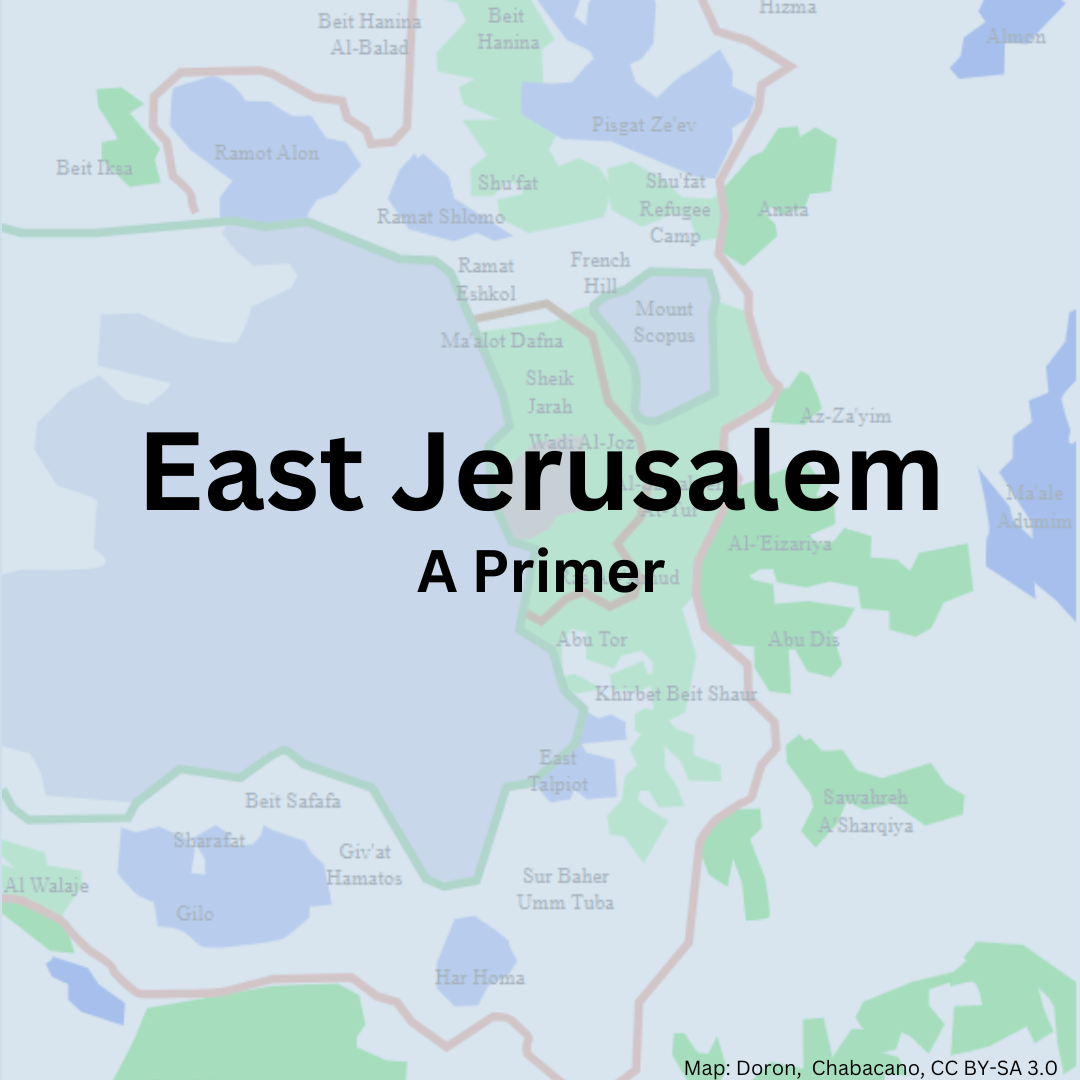Introduction
In the 1948 war, Jerusalem was split into two—the West was conquered and annexed by Israel, while the East, Jerusalem’s Old City and its surrounding neighborhoods, was conquered and annexed by Jordan. Jordan’s annexation was not widely recognized and the international community overwhelmingly viewed the West Bank, including East Jerusalem, as occupied.
In 1967, during the Six-Day War, Israel occupied the eastern part of the city along with the rest of the West Bank and other territories.
It immediately annexed Jordanian Jerusalem and 28 surrounding villages into its new Jerusalem municipality, and together now known as East Jerusalem.
This annexation was then enshrined in law in 1980 through the ‘Basic Law: Jerusalem, capital of Israel, which also declared the entire city as its “complete and united” capital.
This annexation has not been recognized by most of the international community, which considers East Jerusalem occupied territory. The International Court of Justice recently re-affirmed this status and its illegality.
361,700 Palestinians and 233,700 Israeli settlers in 2020 – Israeli CBS data
Residency status
As part of the annexation, Palestinians in East Jerusalem were collectively granted permanent residency status, but not citizenship. This means they have civil and social rights, such as national insurance coverage, but not full political rights—while they are able to vote in the municipal elections, they cannot be elected into the mayor’s office, and cannot run or vote in the national elections, the level at which most decisions that affect them take place.
Many choose to boycott the municipal elections so as to not show acceptance of Israel’s annexation.
This ‘permanent’ residency status is not really permanent—since 1967, 14,643 Palestinian residents of Jerusalem had their residency revoked, most often for living outside the country (including living in the West Bank, which can mean just in the outskirts of Jerusalem) for an extended period of time.
They are, in effect, treated as immigrants in the city of their birth where their families have lived for generations.
Citizenship
Palestinians in Jerusalem can apply for citizenship on an individual basis.
Since Israel’s annexation of East Jerusalem is not recognized by the vast majority of Palestinians, applying for citizenship can be seen as an acceptance of Israel’s annexation. Likewise, because the international community does not accept Israel’s sovereignty over the area, it also has not demanded that Israel grant citizenship to Palestinians in Jerusalem.
Even when people do decide to apply, the process is long and can often end in rejection: Only 34 percent of naturalization applications submitted by Palestinians living in East Jerusalem have ever been approved, meaning applying for citizenship does not guarantee one can obtain it.
Today, only 5 percent of Palestinian residents of East Jerusalem – 18,982 people – have obtained Israeli citizenship.
Settlements – What does the annexation mean in terms of the land?
Almost immediately after 1967, Israel started establishing numerous settlements in and around East Jerusalem, expropriating, for that purpose, 38% of the land, which were owned by Palestinians.
As of 2020, there were approximately 225,000 Israeli settlers living in East Jerusalem settlements. While these are considered illegal under international law as they are part of the occupied West Bank, they are perceived as regular neighborhoods by most Israelis, similar to those in West Jerusalem.
The development of settlements across East Jerusalem has separated Palestinian neighborhoods from one another and separated East Jerusalem from the rest of the West Bank.
Apart from settlement construction, land has also been seized for the establishment of national parks and green/open areas, especially in the area surrounding the Old City. All of this has left little space for Palestinian neighborhoods to develop.
Separation Barrier
The separation barrier, built in the early 2000s, zigzags across East Jerusalem, cutting off the city from Ramallah and the rest of the West Bank and leaving some Jerusalem neighborhoods on the other side of the wall. This had a profound effect on the cultural, economic and social life of Palestinians. The approx. 150,000 Jerusalem residents that now live on the other side of the wall, in neighborhoods such as Kfar Aqab and Shuafat refugee camp, now need to cross a checkpoint to reach the rest of the city, and their needs are almost totally neglected by the Israeli authorities, which provides little to no services in the area. This situation has led to a decline in living conditions and increased uncertainty about the future status of these neighborhoods.
Allocation of resources
Israeli policy in East Jerusalem aims to control more land while limiting Palestinian growth. This is evident in several key areas.
For example, the planning policy intentionally restricts development in Palestinian neighborhoods which, over the decades, has caused a severe housing shortage. For this reason, some Palestininians end up building without a permit, which can then result in their home being demolished.
Additionally, the authorities significantly underinvest in East Jerusalem—for example, despite Palestinians comprising 40% of the population, only 10% of the municipality’s budget is allocated to East Jerusalem. This underfunding results in neglected public infrastructure, including a shortage of 2,447 classrooms for Palestinian students.
These disparities in budget allocation, infrastructure development, and housing policies exacerbate existing inequalities and make it difficult for Palestinian families to grow within their communities.
The Bottom Line
In 1967, Israel occupied and later annexed Jerusalem’s Old City and surrounding neighborhoods, along with smaller, nearby villages. It did so while progressively disconnecting Palestinians in East Jerusalem from the majority of the West Bank, hindering the freedom of movement for Palestinians on both sides of the barrier.
Within Jerusalem, the state has maintained and expanded Israeli control over the area while curtailing the rights of the Palestinian population and limiting its growth, development, and sovereignty claims. This is achieved through a combination of legal mechanisms, citizenship rights, settlement expansion, property acquisitions, budgetary allocations, and urban planning policies that favor Jewish Israeli residents and geopolitical interests over the needs and rights of the city’s Palestinian population.
Full list of sources and follow up :
https://buymeacoffee.com/beccaexplains/east-jerusalem-primer-sources

